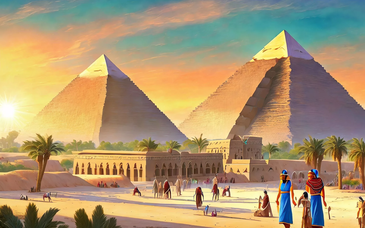| 1859 | American colonel William Loring travels to Europe, the Middle East and Egypt. He meets Egypt’s ruler, Saïd. Construction begins on the Suez Canal. |
| 1861 | The American Civil War begins. Egyptian cotton exports begin to skyrocket. |
| 1862 | Saïd dies; Ismail becomes Viceroy of Egypt. |
| 1865 | The Civil War ends. Bottom falls out of the Egyptian cotton market. |
| 1866 | Ismail purchases the right of primogeniture from the Ottomans. |
| 1867 | Ismail purchases the title of Khedive from the Ottomans. In a meeting with Ismail, French sculptor Frédéric-Auguste Bartholdi proposes the construction of a large statue at the entrance of the Suez Canal. While not commissioned, the project will lead to the creation of America’s Statue of Liberty. |
| 1868 | Ismail meets Thaddeus Mott in Constantinople. Mott convinces the Khedive to use American Civil War veterans to help modernize the Egyptian army. |
| 1869 | The Suez Canal opens amid great fanfare. Mott enlists the aid of William Sherman to find volunteers for the Egyptian army. Their first recruit is William Loring. Ismail is forced to turn over his new ironclad ships to the Ottoman Empire. |
| 1870 | Loring and Henry Hopkins Sibley arrive in Egypt. They are soon followed by another 18 Americans. Charles Stone begins establishing schools for the men in each army battalion. |
| 1871 | Loring is put in charge of Egypt’s coastal defenses, including Alexandria. Aida debuts at the Cairo Opera House. |
| 1872 | William Sherman visits Egypt. The shooting affray in Alexandria takes place. King John is named emperor of Ethiopia. |
| 1873 | Cornelius Hunt becomes the first American to die in the service of Egypt. Free schools for the education of soldiers’ sons are opened. |
| 1874 | Ismail gives Charles “Chinese” Gordon control of the Sudan and equatorial regions. Charles Chaillé-Long travels to Uganda to establish relations with King M’Tesa. On the return journey, he discovers Lake Kioga. Ismail spends some $15 million on the weddings of three of his children. |
| 1875 | The last large influx of American officers, as 11 more arrive. American-led expeditions explore the desert regions of Darfur and Kordofan. Søren Arendrup and much of his Egyptian expeditionary force are wiped out by King John. The Abyssinian campaign begins. Ratib Pasha is put in charge of the expedition, Loring is named second-in-command. Troops begin sailing to Massowah. With his debt problems mounting, Ismail sells more than 175,000 shares of stock in the Suez Canal to England. |
| 1876 | Henry Irgins becomes the final American to join the Egyptian army. Ratib’s army moves into Abyssinia and occupies the Gura Valley. King John attacks the invaders, and nearly routs Ratib’s main force. The Egyptians successfully repel a second Abyssinian attack. By mid-year, the Egyptians abandon the interior and return home. Two commissions begin examining Egypt’s debt problems; English and French overseers are appointed to the Egyptian Ministry of Finance. |
| 1877 | Russia and Turkey go to war; Egypt sends a token force to Bulgaria. Alexander Mason discovers the Semliki River. Loring’s anonymous account of the Gura debacle, “The Egyptian Campaign In Abyssinia,” is printed in Europe and America. Chaillé-Long publishes an account of his explorations, Central Africa: Naked Truths of Naked People. Egypt’s debt crisis worsens. |
| 1878 | Former President Ulysses Grant visits Egypt. The British and French impose financial control over the Egyptian government. The new ministry decides to eliminate more than 80 percent of the army. Nine of the ten remaining American officers are discharged from the Egyptian army, leaving only Charles Stone. Ismail turns his private property over to his creditors. |
| 1879 | Four hundred unpaid Egyptian officers riot; Ismail dismisses the foreign-controlled government. The British and French pressure the Ottoman sultan to depose the Khedive. Ismail is forced to abdicate in favor of his son, Tewfik. |
| 1880 | William Dye’s Moslem Egypt and Christian Abyssinia is published. |
| 1881 | The Arabi revolt begins. The Mahdi begins his rebellion in the Sudan. |
| 1882 | Arabi takes control of the Ministry of War. The British and French demand his removal; riots break out across the country. The British shell Alexandria (the French do not, and lose almost all influence in Egypt). A British land force defeats Arabi at Tel-el-Kebir. In the Sudan, an Egyptian army of 6,000 is massacred by the Mahdi’s forces. |
| 1883 | An Egyptian army of 7,000 under General William Hicks is destroyed by the Mahdi near El Obeid. Charles Stone leaves the Egyptian army. |
| 1884 | Loring’s A Confederate Soldier in Egypt is published. An Egyptian army under British general Valentine Baker is defeated by the Mahdi. “Chinese” Gordon arrives in Khartoum. |
| 1885 | In January, following a ten-month siege, Gordon perishes in Khartoum. A British relief expedition belatedly arrives two days later. The Mahdi dies in June. |
| 1886 | Bartholdi’s Statue of Liberty makes its debut (with help from Charles Stone, Samuel Lockett and James Morgan). Loring passes away in New York City. |
| 1887 | Stone dies in New York. |
| 1889 | King John is killed while fighting Mahdist forces in the Sudan. |
| 1890 | Tewfik dies at the age of 50. |
| 1895 | Ismail dies in Constantinople; he is buried in Cairo. |
| 1899 | Britain finally reconquers the Sudan from the Mahdists. One of Lord Horatio Kitchener’s cavalry officers is a young Winston Churchill. William Dye passes away. |
Timeline of Events 1859–1899
You Might Also Like:
37 B.C.–4 B.C. - The reign of Herod I, a Roman client king of Israel27 B.C.-14 A.D. - The reign of Caesar Augustus, the first emperor of the Roman Empirec. 6 B.C. - The birth of Jesus26-36 A.D. - Pontius Pilate the Prefect of the Roman Empire's Judaea Provincec. 30-33 - The death and resurrection o...
Read More
Rome & Christianity
DateEventca.190-220Tertullian. Joins the Montanist Heresy in 207. Apologeticum, De Spectaculis235Persecution of Emperor Maximinus Thrax. Pope Pontian I (21 July 230–28 Sept. 235) arrested and exiled to Sardinia. On 28 September Pontian resigned the papacy to allow a successor...
Read More

Read More
Adolf Hitler, one of history’s most notorious figures, was born on April 20, 1889, in Braunau am Inn, a small town on the Austrian-German border. His life and actions would lead to global devastation and a profound shift in world history. From his humble beginnings, he rose to lead Nazi Germany, lea...
Read More
Sumerian Timeline
Fifth millennium: Early developments in Sumer
Fourth millennium: Protoliterate period
Third millennium: Rival kings & periods of unification includes Early Dynastic, Sargonic, & Ur III periods
Second millennium's first half: Ascendancy of Amorite dynasties of Isin, then Lar...
Read More
Mesopotamia 9000 - 500 B.C
B.C.HISTORYCULTUREEarly Farming Communities 9000-5000
9000Beginning cultivation of wild wheat and barley and domestication of dogs and sheep; inaugurating of change from food gathering to food producing culture - Karim Shahir in Zagros foothills.7000At Jarmo, oldest known ...
Read More

Read More
c. 1400 BCE
The beginning of Celtic culture in the upper Danube region of central Europe.
c. 1200 BCE - c. 450 BCE
Widest date range accepted by scholars for the Hallstatt culture in central Europe.
c. 900 BCE
Celtic Migration begins in Europe with many Celts landing in Scotland.
c. 800 BCE - c. 600...
Read More
Conquest by Hyksos and Egyptian Expansion to Ramses II
Eventually, like previous dynasties, the Twelfth Dynasty fell. And the Thirteenth Dynasty, at Memphis, waned across its 150 years of rule and fell with what by now was an old phenomenon: invasion by a foreign army, around the year 1650 BCE.
The ...
Read More

Read More
Bible timelines are a useful tool for understanding the historical context of the Bible and the chronological order of events and stories mentioned in the text. These timelines provide a visual representation of the events and figures described in the Bible, and they can help readers to better under...
Read More
Homo sapiens inhabiting China (c. 75000 BC)Ainu thriving in Japan (c. 38000 BC)Jomon culture in Japan (c. 12000 BC)first pottery in Japan (c. 10000 BC)stone age settlements thriving in Canaan (c. 7000 BC)rice cultivation in Yangtze Valley (c. 6500 BC)first settlements on Crete (c. 6000 BC)Ubaid Peri...
Read More
The dates below are some of the most significant dates in biblical history. With these in mind as sequential reference points, and knowing something about each era, other biblical persons and events can be related to them, both in terms of immediate historical context, and also in terms of occurrenc...
Read More

Read More
Welcome to the ideal place to start exploring the wonders of the Ancient Egypt. Find out all about this amazing culture, and learn about the gods they worshiped, the Pharaohs that ruled and the tombs and statues they left behind.
find out about Tutankhamun, Akhenaten and the other celebrities of t...
Read More
Ancient Egypt had its origin in the course of the Nile River. It reached three periods of great pharaonic splendor: the Ancient Kingdom, the Middle Kingdom and the New Kingdom.
Ancient Egypt map domain stretched from the delta of the Nile in the north, to Elephantine Island, where is the first catar...
Read More
From the dawn of history Persia has preserved its individuality while influencing the art, architecture and culture of other countries.
This chronology catalogues and compares Iran's colourful history with that of the rest of the world from 4000 BC to modern times.
1. Chronology BC2. Chronology AD3....
Read More
Mummy and Coffin of Meresamun
Cartonnage, pigment, human remainsThird Intermediate Period, Dynasty 22, ca. 946-712 B.C.Purchased in Luxor, 1920OIM 10797
This colorful cartonnage mummy case, which still contains the mummy of an ancient Egyptian woman, is inscribed with the name Meresamun ("She lives ...
Read More
The Early Dynastic Period -0 : 1 : 2 :
The Old Kingdom -3 : 4 : 5 : 6 :
The First Intermediate Period -7+8 : 9+10 :
The Middle Kingdom -11 : 12 :
The Second Intermediate Period -13 : 14 : 15 : 16 : 17 :
The New Kingdom -18 : 19 : 20 :
The Third Intermediate Period -High Priests (Thebes) : 21 : 22 : ...
Read More
Interesting facts and information about the mummification process.
The mummy shown here dates from the Roman Period. It has a distinctive painting inlaid into the head part, and is intricately bandaged and studded. The feet are molded in gold painted plaster, which is typical of the period.
...
Read More